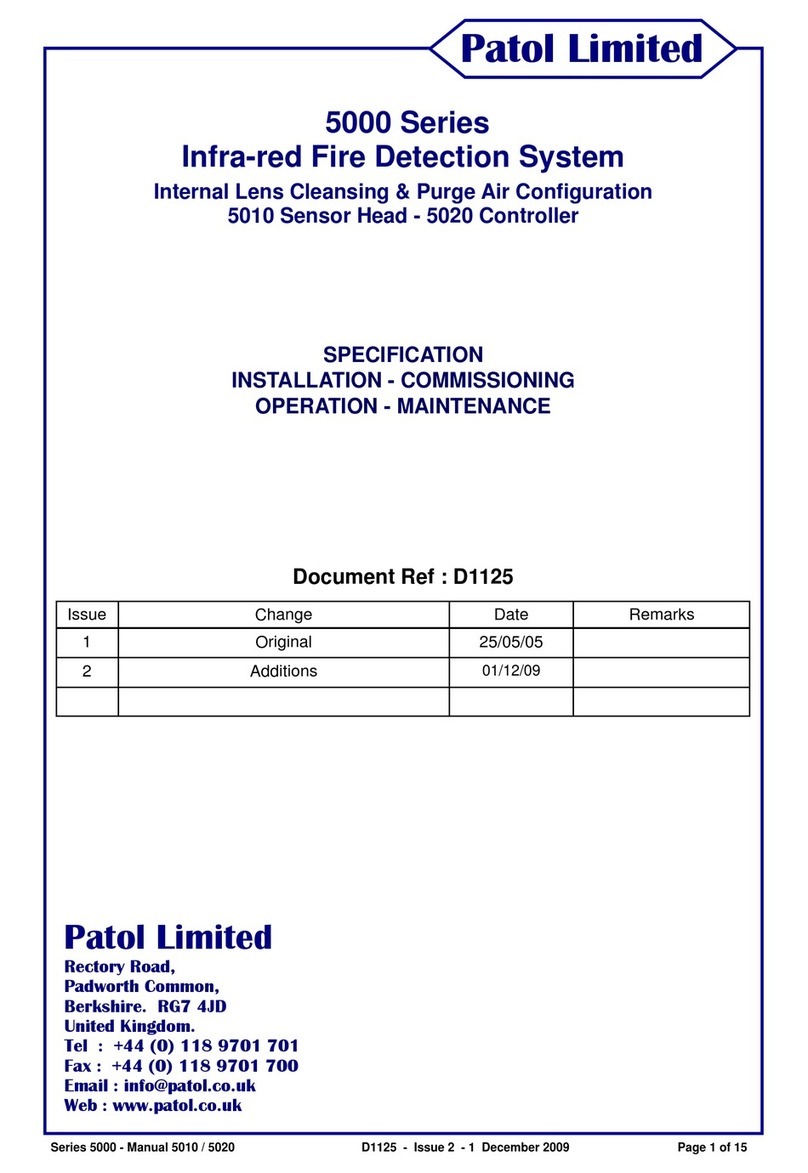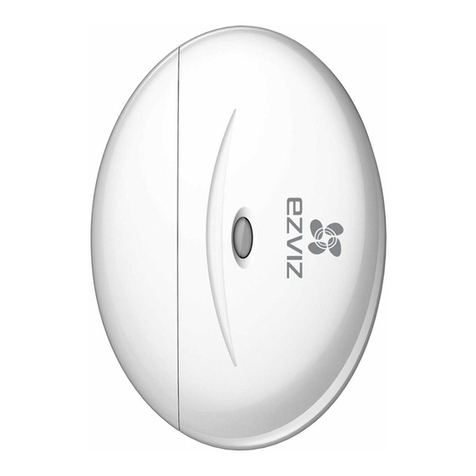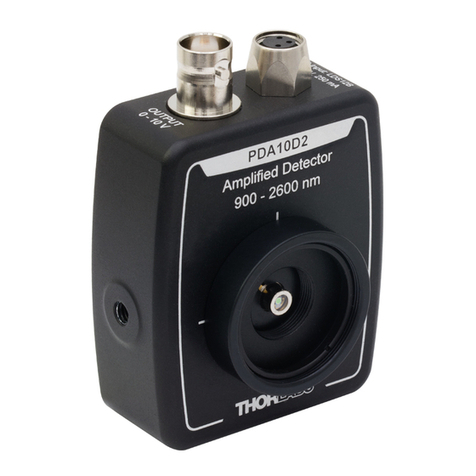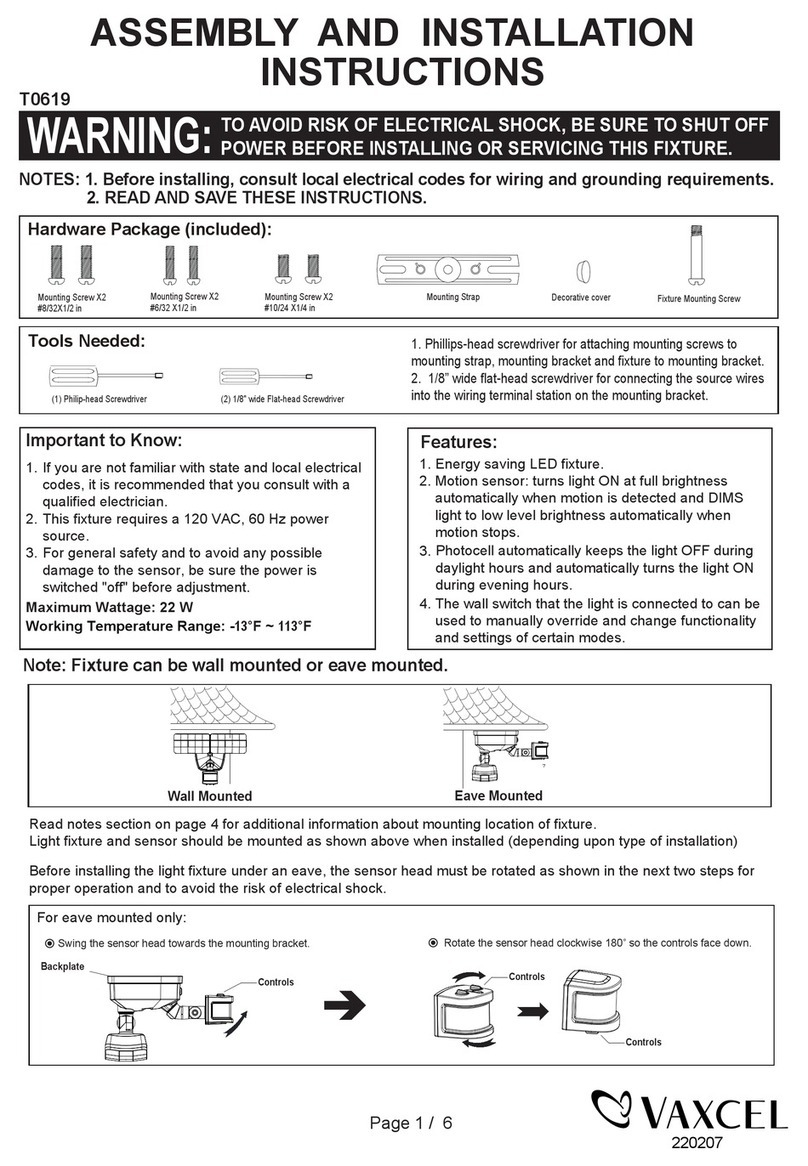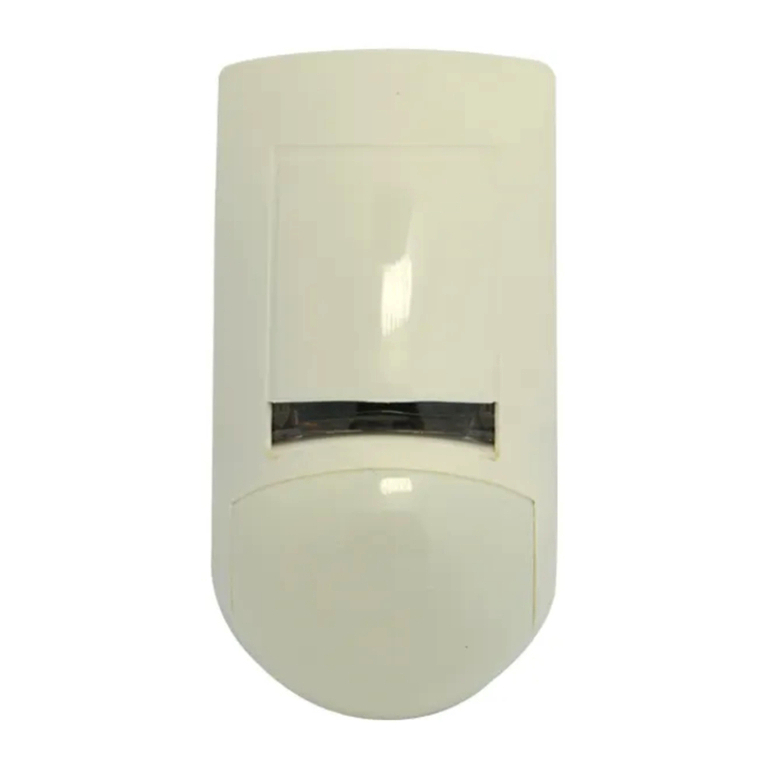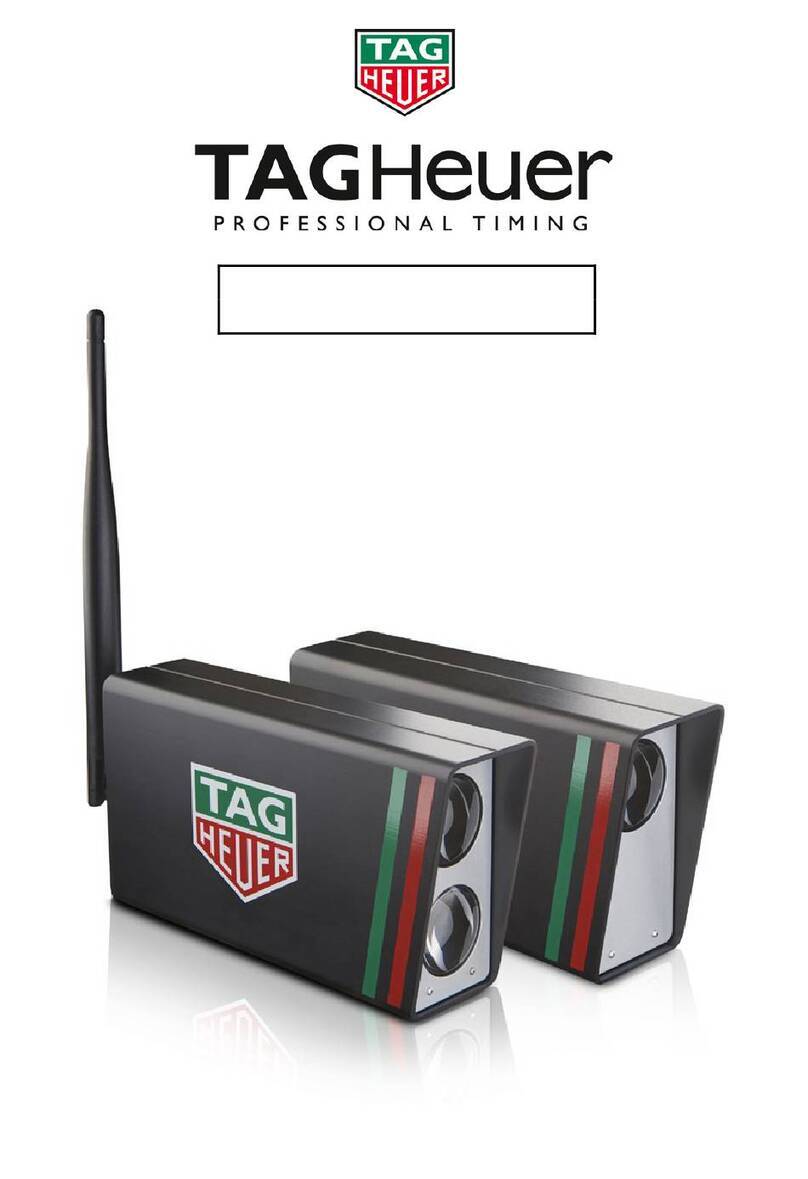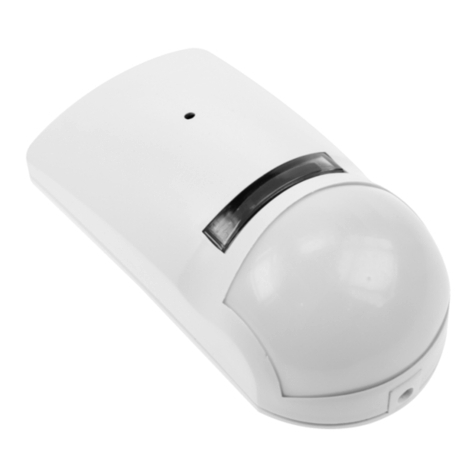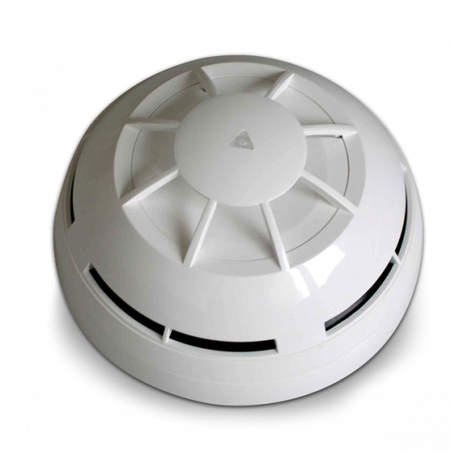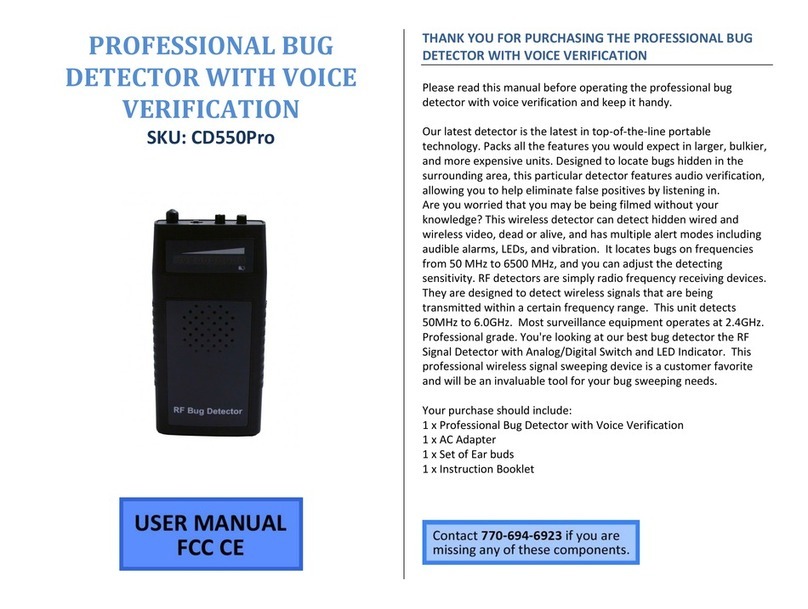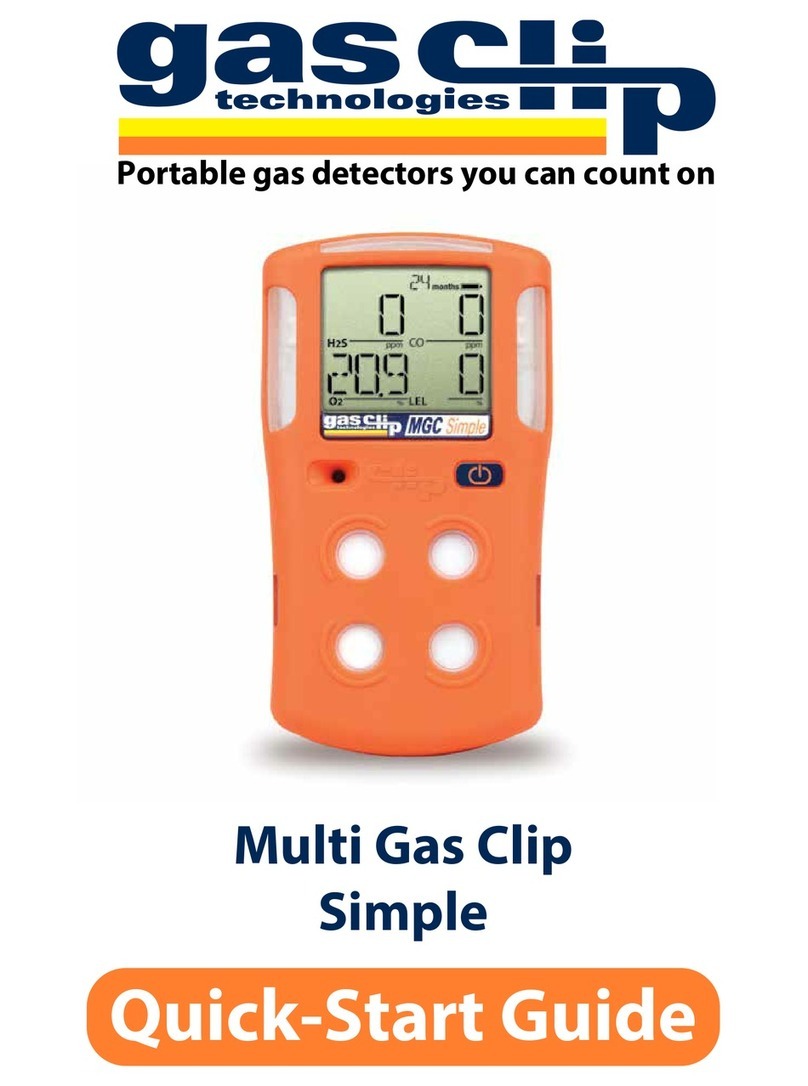Patol 5610 User manual

Page 1 of 16D1198 - Issue 1 - 25 September 2013Series 5000 - Manual 5610
Patol Limited
Series 5000
Type 5610 Infra-red Fire & Heat Detector
SPECIFICATION
INSTALLATION - COMMISSIONING
OPERATION - MAINTENANCE
Document Ref : D1198
Issue Change Date Remarks
1 Original 25/09/13 Approved RJJ
Rectory Road, Padworth Common, Reading,
Berkshire. RG7 4JD United Kingdom.
Tel : +44 (0) 118 9701 701
Fax : +44 (0) 118 9701 700
Email : info@patol.co.uk
Web : www.patol.co.uk
Patol Limited

Patol Limited
INDEX
1. INTRODUCTION
1.1 General
1.2 Principles
2. EQUIPMENT DETAIL
2.1 General Description
2.2 Relay Mode
2.3 Low Power Mode
2.4 Sensor Arrangement
2.5 Specification
2.6 Operational Programmability - SIL Switch
2.7 Connections
3. INSTALLATION
3.1 Detection Coverage
3.2 Supply / Signal Cable
3.3 Purge Air Supply
4. COMMISSIONING
4.1 Cable Checks
4.2 Unit Set Up
4.3 Power Up Procedure
4.4 Hot Body Simulation Tests
5. OPERATION
5.1 Normal
5.2 Alarm Condition
5.3 Reset
5.4 Fault Warning
5.5 Test
6. MAINTENANCE
6.1 General
6.2 Fault Monitoring Functions
6.3 Infra-red Detection
Page 2 of 16D1198 - Issue 1 - 25 September 2013Series 5000 - Manual 5610

Patol Limited
1 INTRODUCTION
1.1 General
The Patol 5000 Series of equipment is specifically designed for the protection of
establishments and systems where a movement of materials with a potential fire hazard is
a routine occurrence.
The 5610 Detector employs enhanced Infra-red monitoring technology that enables the
detection of fire initiating materials, whilst they are being transported, and before they have
reached a flame condition.
The unit has ATEX rating II 2 G D and thus may be installed in hazardous areas.
The system has many applications within industries such as Power Generation, Coal
Mining, Process Plant & Road / Rail Terminals and has been specifically designed to both
meet the rigors of these environments and to provide the reliability required.
The equipment monitors for fire and fire potential of materials in transit. The system can
detect anomalies where combustion has not yet been reached, but where there is sufficient
energy for a fire initiation upon destination arrival.
A typical example is in the coal feed systems on power stations where coal on the ‘out field
stack’ may very well smoulder with little adverse effect for long periods of time. However, if
imported to the power station it may have devastating effects on conveyor systems, holding
hoppers, blending plants etc.
Detection of hazards at temperatures below flame point including both embers and
buried hot spots.
Air purged system for Dusty environments.
Two wire operation - Powered by direct connection to standard fire trigger circuits or
addressable loop interfaces - Signalling mode user configurable to simulate smoke &
heat detector protocols.
Volt free relay contact output operation selectable as standard.
Twin high integrity detection circuit channels for maximum reliability.
Unique reflective cone lensing system provides wide uniform coverage superior to
ember/spark detectors.
Coincidence - Double Knock - option for unit detector channels as standard.
Timed auto reset / coincidence analyser circuit.
Tuned response - solar blind.
High degree of ingress protection - IP66.
ATEX/IECEx approved
Specifically designed for high EMC compliance.
1.2 Principles
The principle of operation is that
temperature dependant black body
emissions occur for all materials.
These emissions range through the
infra red spectrum to visible light.
Both the wavelength and level of
peak energy emission are related to
temperature.
Type 5610 detectors are designed
to detect the changes in these
emissions that occur when a hot
body enters the field of view of the
detector.
By the use of both optical filtering and electronic analysis of the various parameters the
system is blind to visible light from the sun or local luminaires, whilst being able to detect
relatively low temperature material moving through the field of view.
Fig. 1
123456789
200 C
320 C
SOLAR
o
o
10
Typical Black Body Energy Emissions
5000 RESPONSE FILTER
WAVELENGTH (Micrometres)
Page 3 of 16D1198 - Issue 1 - 25 September 2013Series 5000 - Manual 5610

Patol Limited
2. EQUIPMENT DETAIL
2.1 General Description
The 5000 Series system described here comprises two primary elements :-
Detector unit - Type 5610
Compressed Air Supply
The Detector is located above the materials transit path (e.g. conveyor) by means of the
adjustable mounting bracket and aligned such that the monitored hazard passes through
the unit’s field of view. The height and angle of the sensor determine the width of the
monitored path.
The Type 5610 Detector case is equipped with a 10mm hose fitting for connection of a
compressed air supply. This is required such that a positive air pressure is maintained
around the unit’s sensor “windows”.
There is a continuous air flow from the optical path visor which stops dust settling on the
sensor ‘glazed’ optical aperture.
The air purging is essential in dusty environments such as coal conveyors, and is
recommended in even relatively clean applications.
The unit may be user selected to either of two principal operating settings which are
referenced as :-
“Relay Mode” - Operation from a 20 to 30 Vdc supply.
“Low Power Mode” - Operation from a fire alarm trigger circuit / addressable loop.
A description of these arrangements is provided in sections 2.2 and 2.3 following.
MONITORED MATERIALS
SENSOR
COMPRESSED
AIR HOSE
SIGNAL/SUPPLY CABLE
1 to 1.5 m0 to 55
oo
AIR SUPPLY
Fig. 2
Page 4 of 16D1198 - Issue 1 - 25 September 2013Series 5000 - Manual 5610

2.2 Relay Mode
The unit is equipped with relays which are enabled in this mode.
A 24 Vdc (nom) supply is required to operate the unit (max current 24mA).
The unit’s volt free relay contacts are used for signalling of Fire and Fault conditions.
The Fire relay is normally de-energised and energises on an infra-red detection alarm.
The Fault relay is normally energised and de-energises on power supply removal or module
regulation failure. Fault relay signalling can also be arranged for loss of air supply if a
pressure switch is employed.
Refer to figure 3.
2.3 Low Power Mode
In this mode the relays are disabled and the unit’s quiescent supply current is very low and
of a similar level to conventional Smoke and Heat detectors.
By the connection of appropriate resistor values to the sensor’s “solid state” outputs the unit
will signal Normal, Fire & Fault conditions by line current levels, in a manner that permits
the unit to be connected directly to fire control panels via alarm trigger circuits, or to the
monitored inputs of addressable loop interface modules.
The unit can also be employed with the two wire connection to a remote Patol signal relay
module.
Refer to figures 4 & 5.
Patol Limited
ALARM
FAULT
SUPPLY
5610 SENSOR HEAD
Fig.4
*
*Solid State Output Switches 2 WIRE TRIGGER CIRCUIT
ALARM AND
EOL RESISTORS
AS PER FIRE PANEL
REQUIREMENT
CONVENTIONAL
FIRE CONTROL PANEL
AND / OR
PATOL SIGNAL
RELAY MODULE
TWO WIRE CONNECTION
ADDRESSABLE
LOOP INTERFACE
MODULE
ANALOGUE
ADDRESSABLE
FIRE ALARM
CONTROL PANEL
5610 SENSOR HEAD
ALARM & EOL
RESISTOR
CONFIGURATION
AS PER FIG.2
Fig.5
2 WIRE ADDRESS LOOP
SUPPLY
VOLT FREE CONTACTS
FIRE RELAY
(Normally De-Energised)
FAULT RELAY
(Normally Energised)
5610 SENSOR HEAD
Fig.3
ALARM
FAULT
2 WIRE SUPPLY CIRCUIT
24 Vdc
POWER SUPPLY
Page 5 of 16D1198 - Issue 1 - 25 September 2013Series 5000 - Manual 5610

Patol Limited
2.4 Sensor Arrangement
A dual detector channel sensing circuitry is located within an aluminium alloy enclosure
which is mounted by means of an adjustable bracket permitting alignment in both vertical
and horizontal planes. The housing is equipped with a 10mm compressed air hose
adaptor. The signal cable enters through a gland and is terminated at screw terminals.
2.5 Specification
2.5.1 General
a) Outer Case:- Material : Aluminium Alloy
Finish : Red - RAL 3020
b) Termination:- Rising clamp terminals
Cable Core Size : 2.5mm² - 14AWG
c) Temperature :- -20°C to +60°C
d) Weight:- 3kg
e) Purge Air Supply:- Pressure : 175 to 700 mBar (2.5 psi to 10 psi)
Minimum Delivery : 30 litres / min
Input Fitting : 10mm Compressed Air Hose Adaptor
Fig.6
Ø146
141
48
150
FACSIA Ø100
RIGHT ANGLED
AIRLINE ADAPTOR
2x20mm GLAND APERTURES
1x20mmGLANDAPERTURE
Page 6 of 16D1198 - Issue 1 - 25 September 2013Series 5000 - Manual 5610

Patol Limited
2.5.5 Detectors
a) Configuration:- 2 off - Employing reflective cone optical focusing system
Coincident fields of view arranged as separate channels
b) Field Of View:- +5°/-15°(along transit axis path) +/-38°(across transit path)
Refer to coverage chart in section
c) Characteristic Spectral Filter : 5 - 14 µm
Sensitivity : 10 - 40 µW
Transit speed : 0.5 to 6 m/s
Response : 80 - 1000 ºC (170 - 1800 ºF) - See below
NOTE #1 - Air failure signalled if pressure switch employed.
Figure 7 indicates the
correlation between the
temperature and size of ‘hot
spot’ anomalies for a typical
installation to produce one or
more detector channel
activations at various trigger
level settings.
Exact response is dependant
on the emissivity factor of the
monitored material, sensor
orientation and target speed.
Specification - Continued
2.5.2 Internal / Maintenance Features - Accessed on removal of lid / fascia.
a) Indications:- 2 off Red LEDs - One per sensor channel
b) Controls:- Test Push-button
Reset Push-button
c) Program Switch:- Sensitivity : 4 Levels
(SIL 8 Way) Alarm Operation : ‘OR’ / ’AND’ - Latching / Auto-Reset
Auto Reset Timer : 4 Settings
2.5.3 Relay Mode - Direct Supply - Relays Enabled
a) Supply Voltage:- 20 to 30 Vdc
b) Supply Current:- Standby - 9 mA
Fire (Alarm) - 24 mA (max)
c) Alarm Output:- Fire Relay Contact - 1 pole change over - 30 Vdc 500 mA
Normally De-energised
c) Monitor Output:- Fault Relay Contact - 1 pole change over - 30 Vdc 500 mA
Energised Normal - De-energises on supply / air failure #1
2.5.4 Low Power Mode - Line current signalling via Fire Alarm Trigger Circuit
a) Supply Voltage:- 13 to 30 Vdc
b) Supply Current:- Normal / Standby - 350μA (plus EOL *resistor current)
Fire (Alarm) - 5 mA (plus Alarm Load** resistor current)
Fault - <350 uA
c) Alarm Output:- Solid state switch - Fit with Alarm Load** resistor
Normally Off - Alarm Load switched across supply on fire
c) Monitor Output:- Solid state switch - Fit with EOL *resistor
Normally On - EOL open on supply / air failure #1
0100 200 300 400 500 600 700 800 900 1000
1
2
3
4
Temperature Degrees C
250mm Dia.
490 sq cm 100mm Dia.
78 sq cm 50mm Dia.
19.6 sq cm
29mm Dia.
6.45 sq cm
1 sq inch
25mm Dia.
4.9 sq cm
GLOWING / VISIBLE
Fig. 7
Page 7 of 16D1198 - Issue 1 - 25 September 2013Series 5000 - Manual 5610

Patol Limited
2.6 Operational Programmability - SIL Switch
An eight pole SIL switch is located within the unit which programs the unit’s operation. Most
of the various option features are for special applications, factory test, commissioning or
maintenance purpose.
A summary of the switch functions is as follows:-
2.6.1 LED Operation - Pole 1
Normally the internal LEDs will only illuminate on ‘Alarm’ signalling. In the case of
coincident (double knock) operation the LEDs only illuminate when both channels
have triggered. This is to obviate momentary increases in line current for single
channel operations. For factory test and maintenance purpose Pole 1 of the switch
allows the LEDs to individually illuminate irrespective of operating mode. Ref. table 1.
2.6.2 Channel AND / OR selection - Pole 2
The unit can operate such that detection by either sensor channel results on an
alarm output (single knock / OR operation). Alternatively the unit may be set an
alarm output only occurs on detection by both sensor channels (double knock /
coincident / AND operation). Refer to table 1 & 2.7.6.
2.6.3 Non-latching option. - Pole 3
The sensor channels normally latch on detection. A non-latching setting is available
for maintenance, factory test and special application analysis. Refer to table 1.
2.6.4 Auto Reset operation. - Pole 4
When in double knock mode an auto reset is applied after a preset delay .
This only occurs if only a single channel has operated within the delay time. If both
channels have operated then the auto reset is prevented. The delay time is in effect
the scan period for coincidence. An option to auto reset ‘AND alarms’ is provided for
maintenance test purpose. Refer to table 1, 2.6.5 & 2.7.6.
2.6.5 Auto Reset Delay (Scan Period) - Poles 5 & 6
The duration is set by these switch poles . Refer to table 2.
2.6.6 Sensitivity. - Poles 7 & 8
The unit detection level sensitivity is set by these switch poles. The range
approximates to 10 - 40 μW. Refer to table 3.
Pole FUNCTION
1 OFF Channel LED’s only illuminate on alarm
ON Channel LED’s illuminate before Double Knock alarm
2 OFF Double Knock - Coincident Output
ON Single Operation - OR - Output
3 OFF Latching Operation
ON Non-latching Operation
4 OFF Only single detections auto-reset after scan period
ON All detections auto-reset after scan period
Pole AUTO RESET DELAY - SCAN PERIOD
5 OFF
2.6s OFF 1.3s ON 0.9s ON 0.6s
6 OFF ON OFF ON
Pole SENSITIVITY (A=Most : D=Least)
7 OFF
A OFF B
ON C
ON D
8 OFF ON OFF ON
Table 1.
Table 2. Table 3.
Page 8 of 16D1198 - Issue 1 - 25 September 2013Series 5000 - Manual 5610

FIRE ALARM PANEL /
ADDRESS LOOP INTERFACE
FIRE FAULT
SHOWN
IN FAULT
SHOWN
NORMAL
TRIP
1ALARM
2
CONTACTS DISABLED
REMOTE TEST
(OPTIONAL)
ALARM FAULT
(EOL)
23
24
27
28
19
20
21
22
25
26
+24V
RESET
ALERT
0V
LED
+
-
Pressure
Switch
LED
Operation
Selection
24Vdc
POWER
SUPPLY
REMOTE TEST
(OPTIONAL)
FIRE FAULT
SHOWN
INFAULT
SHOWN
NORMAL
TRIP
1ALARM
2
CONTACTS ENABLED
23
24
27
28
19
20
21
22
25
26
+24V
RESET
ALERT
0V
LED
+
-
Pressure
Switch
LED
Operation
Selection
Patol Limited
2.7 Connections
2.7.1 Relay Mode - Direct Supply - Relays Enabled
2.7.2 Low Power Mode - Relays Disabled
Fig. 8
Fig. 9
Refer 2.7.3
to 2.7.6
Refer 2.7.3
to 2.7.6
Page 9 of 16D1198 - Issue 1 - 25 September 2013Series 5000 - Manual 5610

Patol Limited
2.7.3 Normal LED
An LED indicating normal operation may be connected at terminals 23/24.
The LED is illuminated under normal conditions. When terminals 25/26 are open
the LED extinguishing on either electrical supply fault or air pressure failure.
When terminals 25/26 are linked the LED extinguishes on electrical supply fault
only.
The output is constant current regulated at 1.5mA. A low current LED may be
connected in both relay and low power modes. In the latter case the 1.5mA LED
current should be taken into account when determining the value of the EOL
resistor appropriate to any control panel monitoring circuit employed.
2.7.4 Pressure Switch
The compressed air supply may be monitored by connection of a pressure switch
at terminals 27/28. The switch must be normally closed - opening on air supply
failure.
If no switch is employed terminals 27/28 should be linked.
2.7.5 Auxiliary / Local Reset Push-button
A normally open Reset push-button may be connected at terminals 20/22. (The
signal at terminal 22 is switch low / 0V)
2.7.6 Alert Output
A signal at terminal 21 is in effect an open collector switch low (0V) on either
channel detection. This output occurs even if the unit is set for coincident alarm
operation and may be considered as an Alert which will operate for the duration of
the scan period, with auto-reset if coincident condition does not occur. Also refer
to 2.6.2 & 2.6.4.
In relay mode the output may be used for example for connection of a 24V
indicator between terminals 19/21.
In low power mode it is likely that the maximum permissible non-alarm current
parameter of the control equipment monitoring (trigger) circuit will preclude the
use of this output.
2.7.7 Local Alarm indicator
When in relay mode one of the sets of alarm contacts may be employed to switch
a local Alarm LED or Lamp.
In low power mode the indicator should be integrated with the alarm resistor
connection at terminals 2/7. The voltage and current of the device must be
appropriate to the alarm current parameter and load characteristic of the control
equipment monitoring (trigger) circuit.
Page 10 of 16D1198 - Issue 1 - 25 September 2013Series 5000 - Manual 5610

HEIGHT A
o
90
o
CONVEYOR TRANSIT PATH
15
o
5o
Patol Limited
3. INSTALLATION
3.1 Detection Coverage
The angle and height of mounting determine the monitored width.
The example shown on the chart is for a sensor mounted 0.8m above the transit path at an
angle of 0°. This provides a maximum monitored width of 1.3m which would be suitable for
most coal conveyors. Should the most practical mounting height (e.g. 1m) produce a wider
view field than the conveyor this is perfectly acceptable, so long as the “overlap” on each
side is not so large that external hot targets, such as vehicles on an adjacent roadway, are
within the units view.
3.2 Supply / Signal Cable
The Type 5610 Detector outer case has 3 x 20mm cable entries as standard,
Cable terminations are made at rising clamp screw terminal connectors located within the
inner module. The terminals accept wires of up to 1.5mm² (15AWG). Refer to section 2.7
for connections.
To access the terminals it is necessary to remove the lid / fascia and the internal detector
assembly. This is achieved by releasing the outer locking 3mm hexagonal grub screw, then
unscrewing the lid. To remove the internal detector assembly, unscrew the two fixings
labeled A & B (see fig. 13). The detector assembly is connected to the termination board
via a ribbon cable and plug/socket.
Fig. 10
0m 1m 2m 3m 4m
1m
2m
0m 5m
55o
30o45o
0o
o
Angle -A
MONITORED WIDTH
0.8m
1.3m
EXAMPLE
Fig. 12
MONITORED
WIDTH
Fig. 11
Page 11 of 16D1198 - Issue 1 - 25 September 2013Series 5000 - Manual 5610

Patol Limited
When re-fitting the inner detector assembly ensure the external viewing apertures are
positioned above in line with the sensors.
3.3 Purge Air Supply
The unit is equipped with a fitting for connection to a 10mm compressed air flexible hose.
The air supply must be capable of delivering at least 30 ltrs/min at this connection and have
a pressure of 175 to 700 mBar (2.5 to 10 psi).
Fig. 13
To remove lid
unscrew anti-
clockwise
Fixings A and B
External viewing
apertures
Sensors
10mm compressed
air inlet
3mm hex locking screw
Page 12 of 16D1198 - Issue 1 - 25 September 2013Series 5000 - Manual 5610

4. COMMISSIONING
4.1 Cable Checks
The installation wiring should be checked for correct connection, continuity and insulation.
For relay mode implementation the relay coil link connections at terminals 6/7 & 8/9 should
be checked. Refer to figure 8 section 2.7.1.
For line powered (trigger circuit) mode the Alarm resistor at terminals 2/7, and EOL (end of
line) resistor at terminals 2/9 should be checked for both correct value and fitment. Refer to
figure 9 section 2.7.2.
Terminals 25/26 should be linked if appropriate.
4.2 Unit Set Up
The program SIL switch must be set for the required operation.
The setting below is for double channel coincident detection with a 1.3s scan. The unit
latches on coincident alarm until manually reset.
The detection sensitivity is set to level B.
4.3 Power Up Procedure
Note 1: The unit has three signaled / output states which are monitored by
remote equipment. These are referenced as Normal - Fire - Fault in the following.
For relay mode : Normal = Fire relay de-energized & Fault relay energized.
For low power mode : Normal = EOL resistor connected across trigger circuit.
Fault = EOL resistor disconnected from trigger circuit.
Fire = Alarm resistor connected across trigger circuit.
Note 2: The tests of 4.3.2 & 4.3.3 can only be conducted with the enclosure lid /
fascia open. This may not be permissible in hazardous areas in which case go
straight to 4.3.4.
4.3.1 Apply power to the detector. (Connect supply or trigger circuit)
Check supply = 20 to 30 Vdc for relay mode or 13 to 30 Vdc for relay mode.
4.3.2 Operate detector Test PB - Check : Detector Alarm LEDs A & B illuminate.
Operate detector Reset PB - Check : Detector Alarm LEDs A & B extinguish.
4.3.3 A general check of detector field of view may be conducted at this stage whilst the
module LEDs, Reset PB and SIL switch is still accessible. Refer to section 4.4.
For “Single Knock” mode Pole 3 may be set ON for non-latching alarms.
For “Double Knock” mode Pole 4 may be set ON for auto-reset.
The SIL switch must be returned to the setting of 4.2 before proceeding to 4.3.4.
4.3.4 Fit detector lid and connect compressed air hose.
4.3.5 Check at the Detector that purge air is blowing from the optical aperture.
4.3.6 Momentarily remove the electrical supply and check that the unit signals Fault for
the duration of the supply interruption.
4.3.7 If an air pressure switch is employed momentarily interrupt the air supply and
check that a the unit signals fault.
Patol Limited
POLE 1 POLE 2 POLE 3 POLE 4 POLE 5 POLE 6 POLE 7 POLE 8
OFF OFF OFF OFF OFF ON OFF ON
Page 13 of 16D1198 - Issue 1 - 25 September 2013Series 5000 - Manual 5610

4.4 Hot Body Simulation Tests
A heat simulation test should be conducted.
The test is conducted by moving a “hot” (IR emitting) target into the view field of the Sensor
Head and observing / checking the consequential Alarm operation.
It is preferable that the “test target” is of sufficient size and temperature that the simulation
can be conducted at the plane of the monitored path (conveyor) such that the view field of
the Sensor can be validated. However, a smaller and cooler “test target” may be employed
so as to at least confirm basic operation of the sensor. It will be necessary with a “target” of
this nature to introduce it to the view field nearer to the Senor than the “monitored plane”.
When the 5610 detector is connected to fire panel via a conventional trigger circuit or
addressable loop detector interface, latched 5610 detections are normalized by Alarm
Reset operation at the fire panel. Similarly, when in relay mode, reset is conducted by
momentary supply interruption by an external push-button or other means.
Field of view test confirmation (which requires a number of alarm triggers) may more easily
be conducted when the unit’s covers are removed and the internal LEDs, Reset PB and
program SIL switch are still accessible. Refer to section 4.3.2.
If the location of the Sensor is classified as a “Hazardous Area” it will be necessary to make
special arrangements for this testing as the electrical / hot nature of the test simulation may
breach normal site regulations. It may even be that the test is precluded.
Refer to section 6.3 for information on “test targets”.
Patol Limited
Page 14 of 16D1198 - Issue 1 - 25 September 2013Series 5000 - Manual 5610

Patol Limited
5. OPERATION
5.1 Normal
Relay Mode:- Fault relay energized. Fire relay de-energized.
LP Mode:- End of line resistor connected across trigger circuit.
5.2 Alarm Condition
An Alarm condition will occur on abnormal Infra-red detection by the Sensor Head.
Normally this status will Latch On, however in special configurations the condition can be
set to momentary operation - auto resetting after a selected delay.
During the ALARM :-
Either or both internal red LED indicators illuminated.
Relay Mode:- Fire relay energized.
LP Mode:- Alarm resistor switched across trigger circuit.
5.3 Reset
Latched Alarm conditions may be normalized by :-
Momentary interruption of the supply - less than 7V.
When directly connected to a Fire Panel via a trigger circuit or addressable loop
interface this condition will occur on fire panel reset operation.
A local or remote normally closed push-button may also be implemented.
Operation of the internal Reset push-button.
5.4 Fault Warning
Relay Mode:- Fault relay de-energized
LP Mode:- End of line resistor disconnected from trigger circuit.
A fault warning may occur for any of the following:-
Low / failed supply.
Supply less than 20V in Relay Mode.
Supply less than 13V in LP Mode. (Note:- An Alarm will remain latched below the fault
threshold so long as the Reset voltage is not reached.)
Unit internal power regulation circuit fault.
The output will automatically normalize on rectification of the fault.
5.5 Test
Operation of the sensor’s internal Test push-button simulates an alarm as per 5.2.
A remote test push-button has identical result if implemented.
Page 15 of 16D1198 - Issue 1 - 25 September 2013Series 5000 - Manual 5610

Patol Limited
6. MAINTENANCE
6.1 General
It is recommended that a System Log Book / File is raised at the Commissioning Stage and
that the system configuration and initial settings recorded. These should include:-
Operation configuration and Sensitivity - SIL switch set-up.
Supply voltage.
Subsequently all system events should be recorded in the log.
These should include all maintenance activity, changes to settings, Fault warnings and
Alarm occurrences. (including cause and actions taken ).
An operational regime should be developed that includes both frequent inspection of the
Sensor for undue accumulation of dust, and to confirm air (blower) operation. The regime
may encompass use of the Test facility to check basic operation.
In addition, the system should be subjected to a periodic service as defined in the
following.
6.2 Fault Monitoring Functions
A test should be conducted to confirm the correct operation of the fault monitoring circuits :-
Supply Failure - Check as per 4.3.6
6.3 Infra-red Detection
A heat simulation test should be conducted by moving a “hot” (IR emitting) target into the
view field of the Sensor and checking the consequential Alarm operation.
It is preferable that the “test target” is of sufficient size and temperature to enable
simulation at the plane of the monitored path (conveyor) in order to validate the view field of
the Sensor . Smaller and/or cooler “test targets” may be used closer to the Sensor so as to
at least confirm basic operation of the Sensor.
Fig.7 in Section 2.5 indicates the relationship between the surface area and temperature
required for triggering at the various trip settings.
In hazardous areas it may be necessary to make special arrangements for this testing as
the electrical / hot nature of the test simulation may breach normal site regulations. It may
even be that the test is precluded.
Potential “test targets” are :-
Type 5501 Infra-red Radiator - Test and Commissioning Platen - Patol product.
Type 5502 Infra-red Radiator - Test and Commissioning Wand - Patol product.
100W Lamp Bulb - (The Sensor responds to the glass temperature - not the visible light).
Domestic Flat Iron (smoothing iron).
Electrical or Catalytic soldering iron.
Note : Infra-red LED Torches are NOT suitable for testing 5000 Series equipment.
Patol Limited
Rectory Road, Padworth Common, Reading,
Berkshire, United Kingdom. RG7 4JD
Fax: +44 (0) 118 9701700 Web: www.patol.co.uk
Page 16 of 16D1198 - Issue 1 - 25 September 2013Series 5000 - Manual 5610
Table of contents
Other Patol Security Sensor manuals
